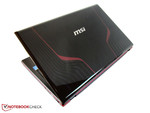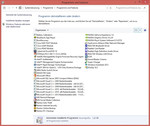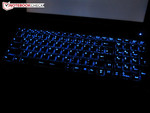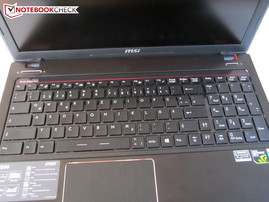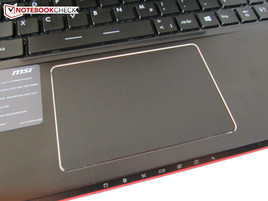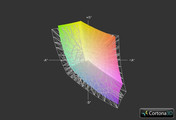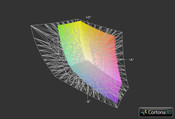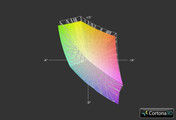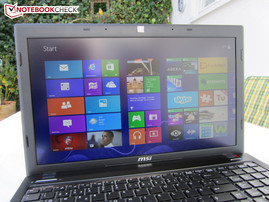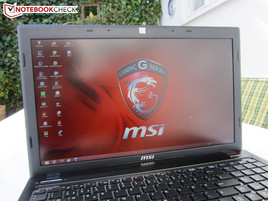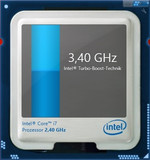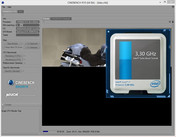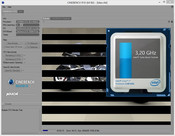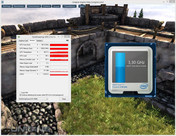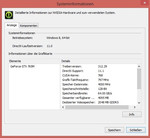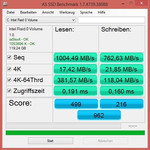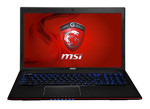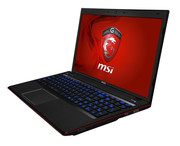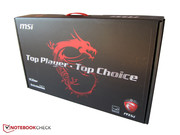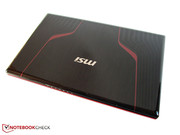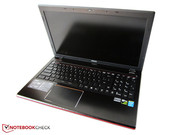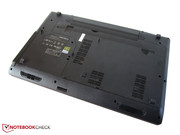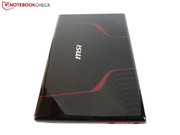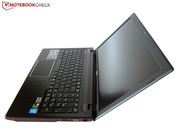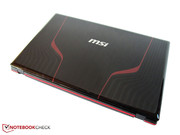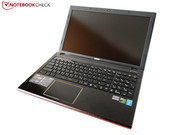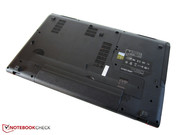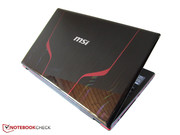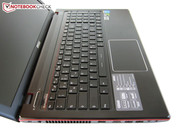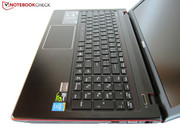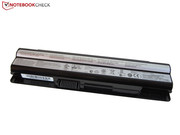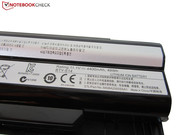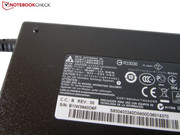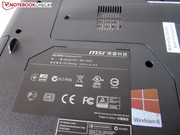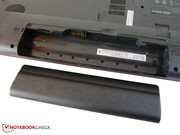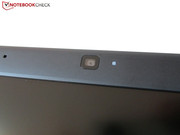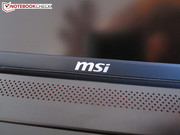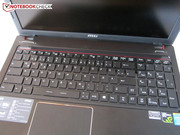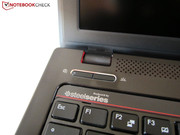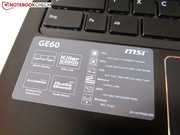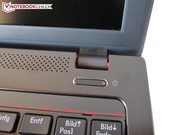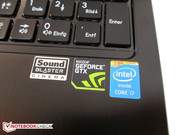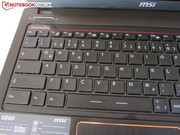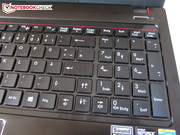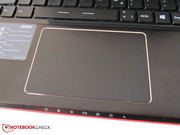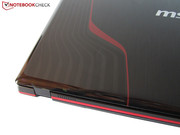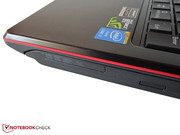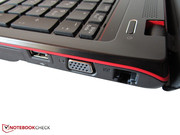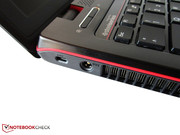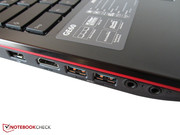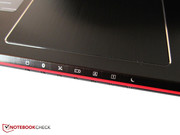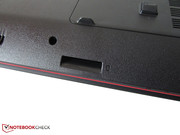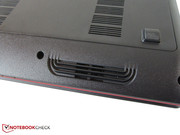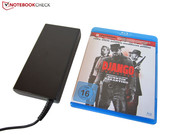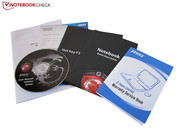Review MSI GE60H-i765M2811B Notebook
For the original German review, see here.
We previously tested the MSI GE70, GS70, GX70 and GT70 and now it is time to take a look at the compact GE60.
Reasons to buy: the anti-glare Full HD display and the powerful quad-core CPU. The Intel Core i7-4700MQ runs at 2.4 - 3.4 GHz and provides enough juice for the dedicated graphics card, the GT 750M or the GeForce GTX 765M. The cheaper configurations use the GT 750M but the GTX 765M is worth the investment.
The Internet business, notebooksbilliger.de, which provided us with our test model, lists this high-end notebook in five different configurations. The pricing starts at 900 Euros (~$1217) with the GE60-i565M245FD (Core i5-4200M) and 1,000 Euros (~$1352) for the GE60-i765M245FD, which offers 4 GB RAM, a 500 GB HDD and a DVD burner but lacks a Microsoft OS (Operating System).
The more interesting models are the GE60-i765M281B (~1,200 Euros/~$1622). Thanks to 8 GB DDR3 RAM, a 1 TB HDD and a Blu-ray combo drive, this laptop will hold its value for a few years. An additional 100 Euros (~$135) will get you the GE60H-i765M2811B. The additional money will procure 2x 64 GB mSATA SSDs, which run in RAID-0 alongside the 1 TB HDD (total storage: 1,128 GB).
If you are willing to invest 1,400 Euros (~$1892), then you can buy the GE60PH-i765M21211 which boasts the best configuration. As only the RAM has been increased (12 vs. 8 GB), we recommend price-conscious buyers to get the GE60 or GE60H instead.
| Model | GE60- i565M245FD |
GE60- i765M245FD |
GE60- i765M281B |
GE60H- i765M2811B |
GE60PH- i765M21211 |
|---|---|---|---|---|---|
| Processor | Core i5-4200M | Core i7-4700MQ | Core i7-4700MQ | Core i7-4700MQ | Core i7-4700MQ |
| Graphics Card | GeForce GTX 765M | GeForce GTX 765M | GeForce GTX 765M | GeForce GTX 765M | GeForce GTX 765M |
| RAM | 4 GB DDR3 | 4 GB DDR3 | 8 GB DDR3 | 8 GB DDR3 | 12 GB DDR3 |
| Storage Device | 500 GB HDD | 500 GB HDD | 1,000 GB HDD | 2x 64 GB SSD + 1,000 GB HDD | 2x 64 GB SSD + 1,000 GB HDD |
| Optional Drive | DVD-Brenner | DVD-Brenner | Blu-ray-Combo | Blu-ray-Combo | Blu-ray-Combo |
| Display | FullHD matt | FullHD matt | FullHD matt | FullHD matt | FullHD matt |
| OS | FreeDOS | FreeDOS | Windows 8 64 Bit | Windows 8 64 Bit | Windows 8 64 Bit |
| Price | 900 Euro | 1,000 Euro | 1,200 Euro | 1,300 Euro | 1,400 Euro |
Case
In the looks department, our test model is the spitting image of its bigger brother, the GE70, which means it offers the same dis-/advantages. In contrast to the much slimmer GS70 Stealth, the case of our test model is not made of aluminum. Instead, it primarily consists of synthetic material. Thankfully, the keyboard borders and the hand-rest regions are made of metal.
MSI has chosen a glossy finish for the display cover. This means the notebook is very sensitive to scratches, fingerprints, etc. Furthermore, it makes the laptop look cheap and the design does not make matters better.
The next product generation should have a matte exterior (as in the past: the GT725). MSI should not have applied the glossy finish to the keyboard base either. Who wants to clean the keyboard every day? The matte screen (borders) can only undo some of the damage.
We were also a little unhappy with the workmanship of the device: the battery was hard to get in, the area between the display and cover is not properly finished and the touchpad is not reliable (more information further down). This is not what we expect in a laptop, which costs 1,300 Euros (~$1757). If we ignore all these flaws, then the notebook has a decent build.
The sturdiness is similar: the top is tough but the bottom (near the vent) can be deformed. As in most notebooks, the display cover is not perfect and the hinges cannot hold the screen securely in position. The user can open the laptop with one hand (the base does not swing along), but if the table is bumped the display will wobble.
The weight and dimensions are better. We believe 2.7 kg (~6 pounds) are reasonable for a high-end notebook. The thickness of 40 mm (~1.6 inches) places our test model between ultra-thin models like the Razer Blade and the heavy 15-inch gaming laptops, like the MSI GT60 (58 mm/~2.3 inches). Thanks to the modest measurements, this notebook is easy to transport.
Connectivity
Ports
The ports are similar to those on the GE70, but MSI has reallocated one USB port and a card reader. All-in-all, the GE60 offers a decent connectivity. If you do not need eSATA, FireWire or DisplayPort, then you will be satisfied with the offering.
External display can be run via the VGA or HDMI interface. Four USB ports (2x USB 3.0) are enough for storage devices or other external peripherals. However, we find the mere two audio jacks to be meager (considering the price class).
MSI will receive some complaints due to the positioning of their ports. Left-handed users will be annoyed as the majority of the ports are placed at the front of the left side and the use of an external mouse might be impeded by the emissions from the vent. Right-handed users should have no problems.
Communication
A Qualcomm Atheros network module is responsible for the RJ-45 Gigabit LAN port. Due to various optimizations, the Killer e2200 is especially good for online games and streaming (finding and prioritizing of high latency files). Thanks to the preinstalled Network Manager, the user can not only observe the network traffic but also regulate it.
In addition, a Realtek WLAN module provides Wi-Fi connectivity. The RTL8723AE (supports WLAN b/g/n and Bluetooth 4.0) can easily hold its own against popular Intel products like the Centrino Wireless-N 2230. Even at a distance of 15 meters (~49 feet) and with multiple walls in between, the network connectivity stayed at 3-5 bars. Most competitors perform poorly in this case.
Maintenance
As this laptop is a shop model, we were not allowed to open it up. Thanks to the predecessor, we can guess that the most important components (storage device, RAM, CPU, GPU & cooling) are accessible.
A classic HDD occupies the 2.5-inch slot and the GE60 offers additional 2x 64 GB mSATA SSDs. The RAM slots can support up to 16 GB (SO-DIMM DDR3-RAM @ 1,600 MHz). It is not possible to swap out the WLAN module.
Software
MSI has gone overboard with software. A media player to read DVDs or Blu-rays (CyberLink PowerDVD 10), a trial version of Microsoft Office 365 and Norton Internet Security make sense, but other programs like the BluStacks App Player belong to Bloatware. Many buyers would like to have a clean Windows installation.
Accessories
The accessories include a drivers DVD, a Quick Start guide, a warranty note and a Recovery manual. If you want to back up your OS on an external storage device, you will have to burn it yourself. However, thanks to a Recovery Partition Windows 8 can be rescued from the hard disk.
Warranty
A standard 24-month manufacturer’s warranty is provided.
Input Devices
Keyboard
MSI uses a chiclet keyboard which was developed through a partnership with SteelSeries. It deserves praises for its backlight: depending on the intensity, it can be a bright or dark blue.
However, we found the layout to be flawed. The " ><|- ", " '# " and Windows keys are not in their standard positions (halved enter key). This tuning may be helpful for hardcore gamers, but typists will miss their standard layout. Other 15 inch competitors like the Clevo W355STQ are more conventional.
The typing feel of the notebook is good. The keys provide decent feedback and are easy to press, but they are not perfect. MSI has provided 15 x 15 mm keys.
Touchpad
Opinions differ about the touchpad as well. On the one hand, the large dimensions (106 x 70 mm/~4.2 x 2.8 inches) and good multi-touch support reflect positively on the device. Even with factory settings, the user can easily turn, zoom or scroll through documents and images. The touchpad is placed slightly to the right and deactivates itself when an external mouse is connected (to reduce unwanted input).
Being a ClickPad, it lacks dedicated keys. The keys built in under the touchpad surface do not work reliably: clicking was often accompanied by an audible cracking noise as if the touchpad had pushed through some resistance. We believe this might be a problem in only our test model, but we cannot confirm this. It is still annoying when the input is not recognized.
The Elan Smart-Pad scores thanks to its good precision and comfortable surface, which offers good sliding properties.
Display
The picture quality of the Full HD display is average. The panel works with an LED backlight and is dubbed the LG Philips LP156WF1-TLF3 (based on TN technology). This panel is found in many notebooks, like the Schenker W503 or the One K56-3N2. It may not be bad but it is not great either.
| |||||||||||||||||||||||||
Brightness Distribution: 81 %
Center on Battery: 246 cd/m²
Contrast: 492:1 (Black: 0.5 cd/m²)
ΔE ColorChecker Calman: 7.89 | ∀{0.5-29.43 Ø4.79}
ΔE Greyscale Calman: 9.25 | ∀{0.09-98 Ø5}
56% AdobeRGB 1998 (Argyll 1.6.3 3D)
59.6% AdobeRGB 1998 (Argyll 3D)
86.6% sRGB (Argyll 3D)
58% Display P3 (Argyll 3D)
Gamma: 2.42
CCT: 11291 K
The brightness averages 230 cd/m². Most panels offer between 300 - 350 cd/m² (see MSI GT70H). An illumination of 81% is not amazing.
The term second-class fits the black value: 0.5 cd/m², which leaves a gray tinge in dark movie or game scenes. A satisfying black is only provided once the black value dips below 0.3 cd/m². The test model offers a contrast of 500:1. In other notebooks, the LG Philips LP156WF1-TLF3 could offer more than 600:1. This places the panel between a 08/15 display (<400:1) and a high-quality TN panel (>800:1).
Let us take a quick look at the color coverage: 82% coverage of sRGB and 56% coverage of AdobeRGB are nothing special. Professional graphics editors will inspect the CalMAN screenshots closely as they display information about the gamma, gray levels, etc. Subjectively, the picture is crisp and colorful. Enthusiastic gamers can pick this laptop without worries.
Performance
Processor
The Core i7-4700MQ is a quad-core from the latest Haswell generation and is finished in the 22 nm format. It uses a 6 MB L3 cache and clocks at 2.4-3.4 GHz (similar to the old Core i7-3630QM but Intel has reworked the architecture radically). The TPD is slightly higher in comparison to the predecessor: instead of 45 W, the new quad-core CPU consumes 47 W.
Further changes can be found in the IGP (Integrated Graphics Processor). The HD Graphics 4000 of the Ivy Bridge series has been replaced by the stronger HD Graphics 4600. The Optimus technology allows the notebook to switch comfortably between the IGP and the dedicated GPU. For simple office tasks, browsing or playing videos, the HD 4600 is responsible, whereas the GeForce GTX 765M takes over when running demanding 3D applications.
The switch is seamless and the user is not aware of it. As such, the user can assign certain programs to run with the dedicated GPU in the Nvidia settings. Usually, this step is not necessary – Optimus works well.
Turbo Boost
Dynamic overclocking is one of the best features offered by Intel CPUs. Depending on the temperature and load, Turbo Boost can increase the speed of the Core i7-4700MQ up to 3.0 GHz. In the Cinebench R10 and Unigine Heaven benchmark, the CPU reached up to 3.2-3.3 GHz. Turbo mode allows the GeForce GTX 765M core to operate up to 902 MHz.
CPU Performance
Our benchmark scores are higher than those of similar notebooks, but the CPU performance of our test model lies in the typical 4700MQ range.
1.51 points is the score achieved in the single core rendering test of Cinebench R11.5 (around 6% faster than the Core i7-3630QM and GeForce GTX 670MX in the Asus G75VX-T4020H - 1.42 points). In the Multi Core test, the Haswell architecture maintains a lead: 6.98 points is a 9% increase on the Core i7-3630QM (6.42 points @ MSI GT60 0NG-405DE).
Despite the meager increase in speed, the Core i7-4700MQ should not be too slow for any programs in the coming years. Sadly, it is far more likely that the GTX 765M will become a limiting factor – at least for games.
| Cinebench R10 | |
| Rendering Single CPUs 64Bit (sort by value) | |
| Core i7-4700MQ | |
| Core i5-4300M | |
| Core i7-4702MQ | |
| Core i7-4800MQ | |
| Rendering Multiple CPUs 64Bit (sort by value) | |
| Core i7-4700MQ | |
| Core i5-4300M | |
| Core i7-4702MQ | |
| Core i7-4800MQ | |
Graphics Card
This is probably the most important hardware of a gaming notebook. Like its bigger siblings, the GTX 770M and the GTX 780M, the GeForce GTX 765M is based on Nvidia Kepler architecture, which is produced in the 28 nm format.
768 Unified shaders and a 2,048 MB GDDR5 VRAM (128-bit interface) make our dedicated GPU the entry-level graphics card to the high-end mobile GPUs. The memory is clocked at 1,000 MHz and the core runs at 850 MHz. In comparison: the GeForce GTX 760M runs at a mere 657 MHz.
The drivers used for our laptop is the older ForceWare 312.29.
GPU Performance
The GeForce GTX 765M cannot run the Fire Strike test from 3DMark 13 fluidly. The GPU score of 2,360 points places the DirectX-11-Modell 50% higher than the GeForce GT 750M (1,573 points @ Asus N750JV-T4110H), but much lower than the GeForce GTX 770M (3,230 points @ Toshiba Qosmio X70-A-11R).
In the Unigine Heaven 3.0 benchmark, the gaps are similar. A resolution of 1920x1080 pixels and normal Tessellation runs on the GE60 at 34.3 fps. A GT 750M provides about 35% fewer frames (22.3 fps @ One K56-3F) and a GTX 770M offers 44% more (49.5 fps @ One K73-3N).
| 3DMark 11 - 1280x720 Performance GPU (sort by value) | |
| GeForce GTX 765M (312.29) | |
| GeForce GT 750M (311.54) | |
| GeForce GTX 760M (311.30) | |
| GeForce GTX 770M (311.27) | |
| 3DMark Vantage - 1280x1024 P GPU no PhysX (sort by value) | |
| GeForce GTX 765M (312.29) | |
| GeForce GT 750M (311.54) | |
| GeForce GTX 760M (311.30) | |
| GeForce GTX 770M (311.27) | |
| 3DMark 06 Standard Score | 19384 points | |
| 3DMark Vantage P Result | 14504 points | |
| 3DMark 11 Performance | 3953 points | |
| 3DMark Ice Storm Standard Score | 64812 points | |
| 3DMark Cloud Gate Standard Score | 12227 points | |
| 3DMark Fire Strike Score | 2228 points | |
Help | ||
Storage Device
The biggest highlight of the GE60H is the RAID 0 setup of two mSATA SSDs. The Toshiba THNSNF064GMCS boasts a Marvell controller and high-quality MLC memory (19 nm).
Thanks to the dual SSD solution, the maximum transfer rates specified by Toshiba are clearly exceeded. 1,004 MB/sec for sequential read and 763 MB/sec for sequential read (AS SSD Benchmark) set new standards and remind us of the RAID system in the GS70 Stealth, which uses two 128 GB SSDs.
Single Solid State Drives are far slower: even the impressive Samsung 840 EVO (Schenker XMG A503) cannot reach the speeds of the RAID setup.
However, the situation changes when dealing with small files. The mSATA duo loses against many competitors as access times of 0.19 and 0.16 ms are not good enough to take the top spot. However, in everyday use, the laptop feels extremely fast.
The RAID system is accompanied by a 9.5 mm Western Digital WD10JPVX-22JC3T0 HDD. We can live with 5,400 rpm operating speed as the HDD offers a large capacity (1,000 GB). In the sequential tests of the CrystalDiskMark, the 2.5-inch drive offered over 110 MB/sec. An average of 89 MB/sec in HDTune deserves praise.
System Performance
The SSD RAID has a big influence on the system performance, as affirmed by PCMark 7: 5,587 points are good enough to compete with other high-end notebooks like the Acer V3-772G, the Razer Blade and the Toshiba X70-A-11R. 20,000 points in PCMark Vantage is not easy to reach, but our test model surpassed it. Overall, the user should expect high system performance from the GE60.
| PCMark Vantage Result | 20368 points | |
| PCMark 7 Score | 5587 points | |
Help | ||
Gaming Performance
The GeForce GTX 765M is a decent gaming GPU. The 28 nm GPU was tested thoroughly using seven games released in 2013.
While Dota 2, F1 2013 and FIFA 14 run fluidly even at "Ultra" settings, Splinter Cell: Blacklist, Saints Row IV, Total War: Rome II and The Bureau: XCOM Declassified were cause for strong stuttering.
The combination of maximum graphics settings and a resolution of 1920x1080 pixels is at times too much for the GPU to handle. A resolution of 1600x900 pixels and high graphics settings should allow the user to run any game fluidly. However, for the hardcore gamers we recommend the purchase of a GTX 770M or GTX 780M.
| F1 2013 - 1920x1080 Ultra Preset AA:4x MS (sort by value) | |
| GeForce GTX 765M (312.29) | |
| GeForce GT 750M (331.40) | |
| GeForce GTX 770M (331.40) | |
| GeForce GTX 780M (331.40) | |
| low | med. | high | ultra | |
|---|---|---|---|---|
| Dota 2 (2013) | 81.4 | 52.4 | ||
| Splinter Cell: Blacklist (2013) | 37.8 | 17 | ||
| Saints Row IV (2013) | 36 | 23.7 | ||
| The Bureau: XCOM Declassified (2013) | 48.6 | 32.4 | ||
| Total War: Rome II (2013) | 90.8 | 12.5 | ||
| Fifa 14 (2013) | 253.7 | 204.4 | ||
| F1 2013 (2013) | 96 | 63 |
Emissions
Noise Emissions
The fan behavior is not ideal. While idle, the cooling is always active and emits 33-35 dB(A) (measured at a distance of 15 cm/~6 inches). Most of the competition work silently in these circumstances. The HDD emissions are limited to the occasional clacking.
In 3D mode, the GE60 is often louder than its 17-inch sibling. For example, while we were running 3DMark 06, the emissions jumped from a clearly audible 45 to a penetrating 51 dB(A), which is the maximum noise emission. We cannot understand why MSI did not build in a few levels in between so that the fan would gently increase its emissions. With active Cooler Boost (special key above the keyboard) the emissions rise further.
Sensitive users should give this model a wide berth. However, few gaming notebooks can offer lower noise emissions.
Noise level
| Idle |
| 33.2 / 33.5 / 34.6 dB(A) |
| DVD |
| 37.5 / dB(A) |
| Load |
| 45.4 / 50.9 dB(A) |
 | ||
30 dB silent 40 dB(A) audible 50 dB(A) loud |
||
min: | ||
Temperatures
The temperatures are also quite severe. While the device remains comfortably cool while idle (~24 °C/75.2 °F), it quickly heats up during load.
The bottom temperature of 51 °C (123.8 °F) is not the problem (near the fan after an hour of stress testing); instead, we feel that the warm hand-rest regions are an issue: up to 44 °C (111.2 °F). This could be very uncomfortable after a while. Thankfully, during typical gaming sessions, the emissions will never rise this high.
The hardware also suffers. While at 100% load (unusual), the Core i7-4700MQ and the GeForce GTX 765M move between 90-100 °C (194-212 °F), despite GPU Turbo being turned off and light CPU throttling (~2 GHz). The cooling system has its limits.
(-) The maximum temperature on the upper side is 46.2 °C / 115 F, compared to the average of 40.5 °C / 105 F, ranging from 21.2 to 68.8 °C for the class Gaming.
(-) The bottom heats up to a maximum of 51.3 °C / 124 F, compared to the average of 43.3 °C / 110 F
(+) In idle usage, the average temperature for the upper side is 24.3 °C / 76 F, compared to the device average of 33.9 °C / 93 F.
(-) The palmrests and touchpad can get very hot to the touch with a maximum of 43.7 °C / 110.7 F.
(-) The average temperature of the palmrest area of similar devices was 28.9 °C / 84 F (-14.8 °C / -26.7 F).
Speakers
MSI has provided this model with four speakers. The speakers are spread out above the keyboard and below the front of the case. Thanks to Sound Blaster Cinema technology and the surprisingly high volume, the sound is good.
External speakers can offer better quality but the notebook manages quite well on its own. The sound is well balanced and clear, and depending on the audio file, the user might even be able to distinguish bass. Many competitors sound worse despite having a subwoofer.
MSI is one of the good manufacturers in this category as can be confirmed by taking a listen to the GT70 (Dynaudio Speaker).
Energy Management
Power Consumption
The consumption values of the test model are close to those of the GE70 and this comes as no surprise as both models use almost identical components. While idle, the Nvidia Optimus technology can help keep the power consumption at a modest 9 - 27 W (depending on the power profile and the brightness).
While in 3D mode, the GeForce GTX 765M takes over and forces the numbers much higher. In the first cut of 3DMark 06, we measured around 94 W (GE70: ~97 W). At full load, the notebook consumes a maximum of 122 W, which means the power adapter is optimally used.
| Off / Standby | |
| Idle | |
| Load |
|
Key:
min: | |
Battery Life
Due to the low battery capacity (49 Wh, 4,400 mAh), the run times are average. After a mere 60 minutes of gaming or 2.5 hours of watching a DVD, the battery is depleted. Wireless surfing lasts 3 hours on this test model before the user needs to charge it again. The Battery Eater Reade'rs test could only run with the GeForce GTX 765M and as such we could not provide an idle run time.
Pity: according to 3DMark 13, the graphics performance drop about 85% on battery use (GPU score: 350 instead of 2,360 points).
Verdict
We believe that, for gamers who do not want to shell out more than 1,500 Euros (~$2028), the GE60H is a good option. Thanks to the intelligent hardware choice (quad-core CPU, high-end GPU and mSATA SSDs), the user will enjoy high-level all-around performance. This special RAID-0 setup may have some problems dealing with small files, but it truly impresses with lightning fast performance.
Although the display and the speakers are not as amazing, the picture and sound quality are good enough for the price. The simple maintenance, backlight and Blu-ray drive are additional pros (the optical drive reader had a few issues reading some DVDs in the test). Nvidia Optimus allows the laptop to consume a modest amount of power when high GPU performance is not needed.
Sadly, the manufacturer has thrown in a lot of unnecessary pre-loaded applications. The glossy display cover, the weak battery and the multiple workmanship flaws negatively affect our overall impression of the device. A better cooling system might have even helped keep the temperature and noise emission down.
The main competitor of our test model is the Clevo W355STQ Barebones. A similarly equipped Schenker XMG A503 costs 1,300 Euros (~$1757), which places it at the level of the GE60H.





